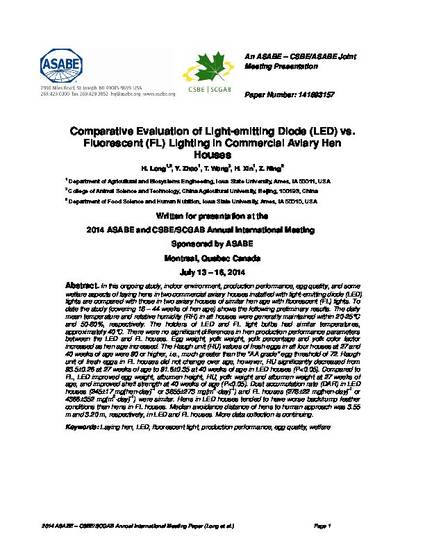
In this ongoing study, indoor environment, production performance, egg quality, and some welfare aspects of laying hens in two commercial aviary houses installed with light-emitting diode (LED) lights are compared with those in two aviary houses of similar hen age with fluorescent (FL) lights. To date the study (covering 18 – 44 weeks of hen age) shows the following preliminary results. The daily mean temperature and relative humidity (RH) in all houses were generally maintained within 20-25°C and 50-80%, respectively. The holders of LED and FL light bulbs had similar temperatures, approximately 40°C. There were no significant differences in hen production performance parameters between the LED and FL houses. Egg weight, yolk weight, yolk percentage and yolk color factor increased as hen age increased. The Haugh unit (HU) values of fresh eggs in all four houses at 27 and 40 weeks of age were 90 or higher, i.e., much greater than the “AA grade” egg threshold of 72. Haugh unit of fresh eggs in FL houses did not change over age, however, HU significantly decreased from 93.5±0.26 at 27 weeks of age to 91.6±0.35 at 40 weeks of age in LED houses (P<0.05). Compared to FL, LED improved egg weight, albumen height, HU, yolk weight and albumen weight at 27 weeks of age, and improved shell strength at 40 weeks of age (P<0.05). Dust accumulation rate (DAR) in LED houses (245±17 mg[hen-day]-1 or 3855±273 mg[m2 -day]-1) and FL houses (278±22 mg[hen-day]-1 or 4366±352 mg[m2 -day]-1) were similar. Hens in LED houses tended to have worse back/rump feather conditions than hens in FL houses. Median avoidance distance of hens to human approach was 3.55 m and 3.20 m, respectively, in LED and FL houses. More data collection is continuing.
Available at: http://works.bepress.com/tong_wang/26/
